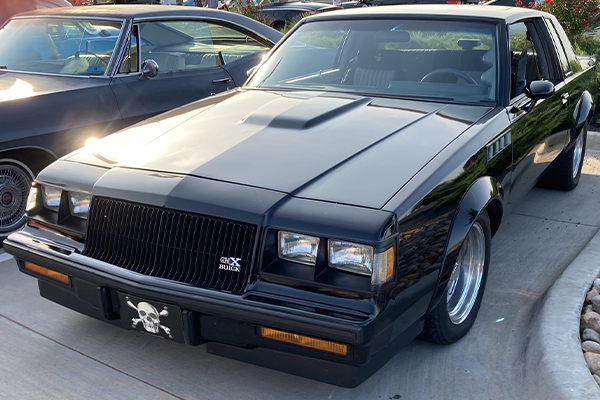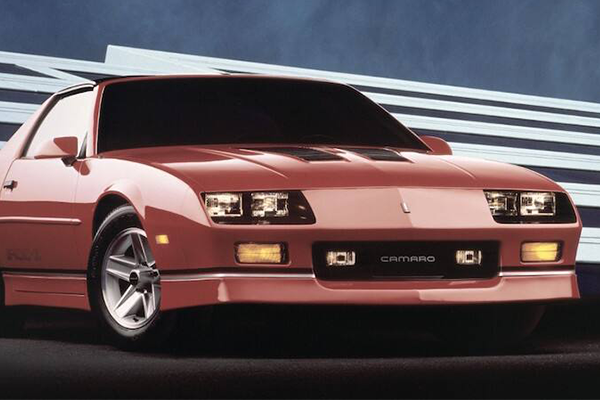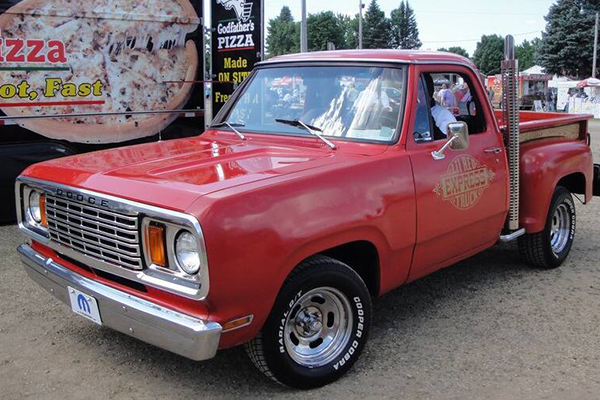From timeless icons to everyday essentials, Crucial Cars examines the vehicles we can’t live without. In this installment, we dig deep into one of the baddest muscle cars in the land: the mighty Dodge Charger.
 Calling the Dodge Charger a Crucial Car is kind of like calling asphalt black. It pretty much goes without saying. You'd be hard-pressed to find another model through the years that's been as meaningful to enthusiasts as the Charger.
Calling the Dodge Charger a Crucial Car is kind of like calling asphalt black. It pretty much goes without saying. You'd be hard-pressed to find another model through the years that's been as meaningful to enthusiasts as the Charger.
Changing appearances
 1966 Charger
1966 Charger
Source | Mopar Muscle Magazine Introduced in the 1966 model year, the First Generation ('66-'67) Dodge Charger came on to the scene amidst the stiff competition from the Ford Mustang and, one year later, the Chevy Camaro. The Charger was Dodge's attempt to change the view that Chrysler cars looked old, and while this two-door, fastback roof vehicle with a 318 cu in (5.2 L) V8 with a three-speed floor shifter certainly looked like the muscle car everyone wanted, sales were low.
A star is born

1969 Dodge Charger For 1968-1970, the Charger was redesigned and so started the second generation. This generation Charger is what everyone knows today thanks to its on-screen appearances in Bullitt, as the nemesis car, and in Dukes of Hazzard as the "General Lee". As you can probably guess, the celebrity prowess of the car and its upgraded look helped Dodge make its mark in the modern style and sales increased. Still based on the Chrysler B platform, the upgrade featured aesthetic changes to the exterior including an undivided grille, rounded tail lights, and hidden headlights. Enthusiasts would call it a "Coke bottle" shape and even more would describe it as perfect. But under that facelift, the powertrains remained unchanged from 1967 with the 230-hp 318 V8 standard and the "Charger R/T" models having the 375-hp 440 V8 in its engine bay. Three-speed and four-speed manual, and three-speed automatic transmissions were offered. The 383 V8 was offered as an option in regular Chargers while the 426 Hemi made its way into 467 Charger R/Ts.
 1969 Dodge Charger Daytona
1969 Dodge Charger Daytona
Source | CarPro USA
In 1969, Dodge decided to mold the Charger into a race car. Their first attempt to turn the Charger into a winner was the special "Charger 500" which used a flush-mounted front grille with exposed headlights and a modified rear window also mounted flush with the trailing edge of the roof. This Charger was Dodge's response to the Ford Torino, and despite their attempts, it was no competition so Dodge went back to the drawing board that same year. With some modifications, like a slicker body, added drooped fiberglass nose, and a tall rear wing for downforce, the Charger Daytona was born. This bold and radical aerodynamic experiment paid off. In fact, a Charger Daytona, driven by Buddy Baker, was the first stock car to lap at more than 200 mph. The Charger Daytona was discontinued from the 1970 lineup, but was still used in NASCAR.
Third generation: 1971-1974
Although not as beautiful as the previous model, the third generation Charger was introduced for the 1971 model year. Its Chrysler B platform had to be modified to meet emissions and safety regulations, and a few cosmetic changes were made including a split grill, semi fastback rear window, and a ducktail spoiler. The 1973 and '74 Chargers were similar, but with small changes to the grill and headlamps. Sales increased still on the Charger but speculation says that's because at that same time, Dodge discontinued its Coronet, so the Charger was the only two-door, intermediate-size body style left.
Attempt at luxury
 1978 Charger ad
1978 Charger ad
For the fourth generation ('75-'78) Charger, Dodge attempted to move the model into the growing personal luxury car market in the 1975 model year. Looking very similar to the Chrysler Cordoba, this vehicle featured sharp edges, long, oversized hood, large grill, and massive chrome bumpers. Offered only as an SE, the 1975 Charger was available with a 360 cu in (5.9-liter) V8 with the two-barrel carburetor and 180 horsepower. The optional four-barrel carb could produce 200 hp. The only transmission available was a three-speed automatic. The 1976 and '77 models were virtually the same and by 1978, the Charger had been replaced with the Magnum. Sales were very low for this generation Charger, but enthusiasts still held dear their previous generation models.
Fifth Generation: 1982-1987
Unlike any of its predecessors, the 1982 Dodge Charger was actually introduced as the Omni 024 during the '79 model year. This hatchback, three-door coupe used the front-drive platform found on the very plain Dodge Omni and Plymouth Horizon economy cars. The Omni itself was deemed ordinary, but not completely terrible. In 1982 the Charger name was applied and the vehicle featured Dodge's larger 2.2-liter, SOHC. Four was fitted to the car as an option in place of the standard 1.7-liter engine. The 1.7 was rated at just 63 hp, so the move up to the 2.2's 84 hp was a welcomed increase. The standard transaxle with the 2.2-liter engine was a five-speed manual and a three-speed automatic was optional. The 024 and Omni names disappeared in 1983 and brought to the stage was the new Shelby Charger.
 1985 Shelby Charger
1985 Shelby Charger
Source | BangShift.com
Developed by the legendary Carroll Shelby, the Shelby Charger was offered with a turbo version available in 1984 producing 148 horsepower (110 kW) at 5600 rpm and 160 pound-feet (220 Nm) of torque at 3200 rpm. While the Shelby Charger was generally a better performer than other Chargers, Motor Trend said, "the engine pulls hard." Acceleration on the Shelby was just so slightly better than the Charger 2.2 for Motor Trend. The Shelby made it to 60 mph in 9.6 seconds and consumed the quarter-mile in 17 seconds at 82.9 mph. From 1983-1987, the Charger lineup got upgrades here and there but the Shelby changed most of all. in 1985 the Shelby got an expanded color palette, including the garnet red base paint. In addition, extra speed came with the fitment of a turbocharged and electronically fuel-injected version of the 2.2-liter engine. Rated at a robust 146 hp, this was a seriously quick machine for the time. All Chargers for 1986 got a new third brake light on their rear hatch as required by law, but mostly things remained unchanged. In 1987, the Charger was losing steam but the Shelby pressed forward with the introduction of the Shelby Charger GLH-S. This vehicle's turbocharged four-cylinders pushed horsepower to 175, an increase of 30. The Shelby would fade out as did other Chargers of the time.
19 years later
Back with a vengeance in 2006, the Charger got back to its muscle-car roots, with one exception: it's got four doors instead of two.
 2015 Dodge Charger
2015 Dodge Charger
From the get-go, the four-door Charger has been available with a brawny 5.7-liter Hemi V8. Now, does it truly have a hemispherical combustion chamber like Chrysler's so-called "Elephant Engine," the monstrous 426 Hemi from the '60s? Some say no, because the chamber's too shallow. But when an engine hauls this much you-know-what, who cares? Initially rated at 340 horsepower and 390 pound-feet of torque, the 5.7-liter Hemi has seen various improvements since, with output now creeping toward 380 hp and 400 lb-ft. But the basic design remains remarkably true to the original Hemis from my childhood, and if you ask me, that's pretty doggone cool. Of course, the modern Charger offers other Hemis, too -- and by "other," I mean bigger and better. There's the Charger Hellcat's supercharged 6.2-liter Hemi, of course, which makes an insane 707 hp. But that's not the one I want, believe it or not. I want the 6.4-liter Hemi, naturally aspirated, with 485 hp and 475 lb-ft. It sounds like NASCAR when you're on the throttle, and if you get the Charger Scat Pack model, you can have all that motor for a shade over $40 grand.
Luxury-Car Credentials
Underneath, the current Charger dates back to the ill-fated Daimler-Chrysler merger, which is actually a very good thing for Dodge. Basically, Mercedes shared its midsize sedan platforms and suspension technology with Chrysler, and the Charger's still using that Benz know-how on the road today. Listen, don't knock it just because it's not the latest and greatest; Mercedes has been building tank-like sedans for decades, and that's exactly what the Charger feels like from behind the wheel. It's large, it's hunkered-down, and it's unflappable at any speed. Bottom line, it's a luxury car in disguise, and that even goes for the ambient noise at speed -- it's almost nonexistent.
Aftermarket Support From the Factory
 Dodge Charger
Dodge Charger
One of the great things about Dodge performance cars is that they're backed by a factory-certified speed shop. Mopar is the name, and personalizing your Charger is what they're all about. I'm talking about big wheels, slammed suspensions, audio upgrades, you name it. They'll even help you squeeze some more power out of that Hemi if you want, and they'll certainly hook you up with an awesome exhaust system to make it sing. If you're a Charger fan, the stock specification is just a starting point for your creativity, and Dodge knows it.
What memories or facts do you have about the Dodge Charger? Tell us in the comments.








